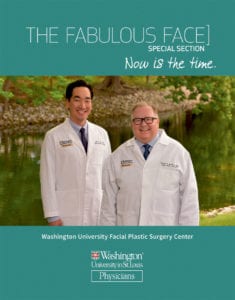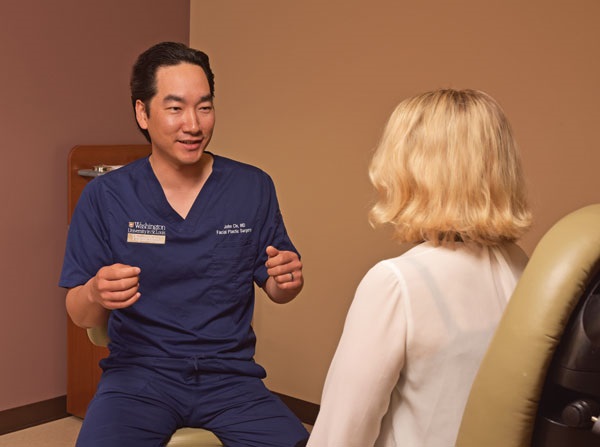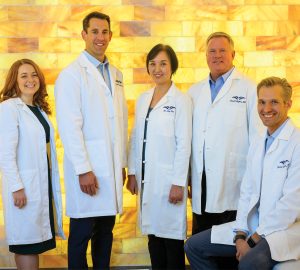In the past, celebrities like Jennifer Grey and Jennifer Aniston gained attention for plastic surgery that drastically altered the look of their noses—and their entire faces. Today, however, the emphasis is on subtle changes that preserve the patient’s unique facial characteristics.
The nose is an area where modern techniques can improve both form and function for many people, according to Washington University facial plastic surgeon Dr. John Chi. He says the physicians of the Washington University Facial Plastic Surgery Center are experienced in helping patients achieve natural results, whether the reason for surgery is medical, cosmetic or both.
“Most patients have a combination of aesthetic and functional concerns regarding their noses,” he explains. “We tend to focus on this feature when we meet people for the first time and when we look at ourselves in the mirror. And physicians are acutely aware of how nasal breathing affects quality of life.” Rhinoplasty, or reshaping the inside or outside of the nose, is an opportunity to impact a patient’s life positively in both areas, he says.
 Washington University plastic surgeon Dr. Gregory Branham says the reasons for this surgery are varied. “You might have a deviation of the nose’s inner or outer structure caused by an accident or sports injury, or by less common conditions like a cleft lip or palate,” he notes. “Or you may want to reshape the nose for cosmetic reasons. We normally think of rhinoplasty patients in three categories: those who are having a procedure for the first time and have adequate tissue to reshape; those who have had a prior procedure or injury that needs revising; and those who want tissue taken away because of a bulge or bump.”
Washington University plastic surgeon Dr. Gregory Branham says the reasons for this surgery are varied. “You might have a deviation of the nose’s inner or outer structure caused by an accident or sports injury, or by less common conditions like a cleft lip or palate,” he notes. “Or you may want to reshape the nose for cosmetic reasons. We normally think of rhinoplasty patients in three categories: those who are having a procedure for the first time and have adequate tissue to reshape; those who have had a prior procedure or injury that needs revising; and those who want tissue taken away because of a bulge or bump.”
Nose injuries and deformities can interrupt healthy slumber due to snoring and sleep apnea, and they may cause the patient to have trouble getting enough air during strenuous activity, Branham says. For example, a deviated septum—the wall between your nasal passages—can impair breathing if it’s not properly realigned, he notes.
Both doctors say that when a patient is having surgery to fix a structural problem, it’s a good time to correct any cosmetic issues as well. “When patients come in to discuss the appearance of their noses, they are hoping to achieve cosmetic goals without sacrificing function, and vice versa,” Chi says. “After surgery, they often wonder why they put off having rhinoplasty as long as they did.”
Branham says rhinoplasty can be completed in a variety of ways, depending on the patient’s needs. Bone, cartilage and skin can be reshaped or removed, and if volume needs to be added, cartilage can be grafted from other areas of the body like an ear, rib or the septum itself. Surgeons also can use implants made of materials like Goretex. Recovery times vary; usually, the physician rechecks the patient a week after surgery, and some normal activities can be resumed after that. “Most people take about a week off work,” Branham notes. “There may be some stuffiness and pain comparable to that of having your wisdom teeth removed. If you’re young, any bruising probably will resolve in a week; if you’re older, it may take longer. Skin and other tissues become less elastic and resilient as we age.”
The patient’s overall health and medical history are important factors in rhinoplasty, according to Branham. The toxic ingredients in cigarettes can affect the body’s ability to heal, so smokers considering surgery are encouraged to permanently quit. And people with heart disease and other health problems may not be good candidates. Whatever the patient’s reason for reshaping the nose, Branham and Chi stress that they counsel patients carefully to make sure rhinoplasty is the right choice for them.
Washington University Physicians offers comprehensive services in plastic and reconstructive surgery. Pictured on the cover: John Chi, MD, and Gregory Branham, MD. For more information, call 314.996.3880 or visit facialplasticsurgery.wustl.edu.
Pictured at top: Dr. John Chi works with a patient.
Photo courtesy of Washington University Physicians
Cover courtesy of Washington University Physicians









1 Comment
Comments are closed.